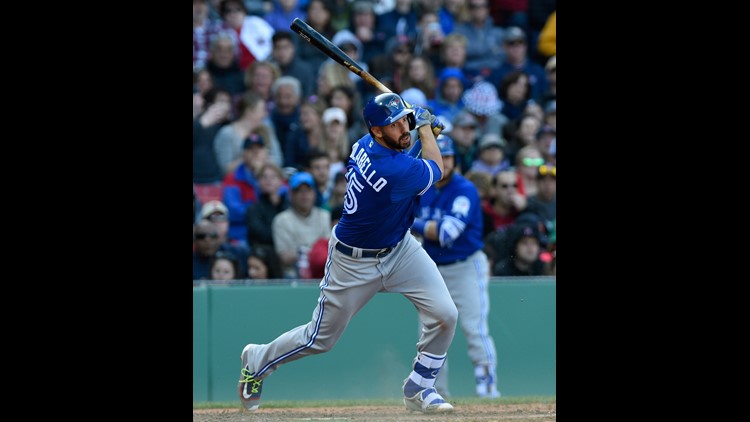It was a much simpler decision back in the day, with only a morals test staring Major League Baseball players in the mirror, and not an actual steroid test.
Now, with a stringent drug testing program, and the punishment increasing from 10 games to 80 games in the last decade, performance-enhancing drug use comes to a roll of the dice.
Or a referendum on the intelligence of the user.
You can believe your chemist that designer drugs will leave your system by the time you show up to work the next day, or take the gamble that a drug-testing official won’t be awaiting to take a urine sample along with your morning coffee.
Maybe this is what happened to Toronto Blue Jays first baseman Chris Colabello when he was popped last week for taking anabolic steroids.
Or then again, maybe he was actually taking something more sophisticated, and was simply victimized by the sloppy work of an underground chemist.
Colabello was suspended 80 games last week for using Oral Turinabol, an old-fashioned steroid developed by the East Germans in the 1960s as part of a government doping program. It was the same drug for which Philadelphia Phillies pitcher Daniel Stumpf tested positive earlier this month. And the same substance former UFC heavyweight champion Frank Mir was caught using, and now faces a two-year ban.
We may never know what really happened, unless Colabello shocks us all, and comes clean.
All we know is that Colabello issued a statement Friday expressing surprise that the substance - classified by MLB as dehydrochlormethyltestosterone - entered his system, and pleaded that “before anyone passes judgment on me they can take a look at the man that I am, and everything that I have done to get to where I am in my career.’’
It’s an explanation Victor Conte, former founder of BALCO whose doping clientele included some of the greatest athletes in the world, has too often heard, along with the rest of us.
Still, something about this is strange. Colabello is at least the fourth major leaguer busted for that drug since last September, but yet, Conte struggles with the concept that Turinabol is making a comeback.
Conte instead wonders if this is the latest wave of athletes utilizing inferior chemists.
Find a good one - as 14 of the 16 players ensared in the 2013 Biogenesis scandal taught us - and you can avoid detection by baseball’s drug testers.
“If you’re smart, you’ll never get caught,’’ Conte told USA TODAY Sports. “The research shows that if you go home from the ballpark, and take a fast-acting testosterone, it will peak at 1 in the morning, get down before the 4-to-1 TE ratio by 4 in the morning, and by the time you get to the ballpark, you can’t test positive. That’s what (Alex Rodriguez) and all of those guys in Biogenesis were doing.
“So to get caught now, you’ve got to be pretty dumb. And to use Turinabol, that’s dumber than dumb. Nobody with any brains are using Turinabol. That’s just stupidity.”
Conte, an expert on performance-enhancing drugs, but not so much baseball, had never even heard of Colabello until the suspension, but had a simple question Sunday evening.
“So tell me,’’ Conte asked, “was there a spike in his performance?’’
Uh, yes, you tell him: Colabello was one of baseball’s finest feel-good stories. This is a kid who spent seven years in independent ball before a major league franchise took a flyer on him.
He broke Hall of Famer Kirby Puckett’s Minnesota Twins’ franchise record with 27 RBI in his first 23 games in 2014. He set career highs in 2015 with the Toronto Blue Jays, batting .321, with 15 homers, 54 RBI and an .886 OPS - a 237-point leap from his two seasons with the Twins before they waived him in December 2014.
With the Blue Jays it seemed, at the age of 31, he had arrived.
“So why are people surprised?’’ Conte asks you. “Come on, how do you think that was possible?
“Any time you see a spike in numbers in this, numbers he never put up before, to go along with an intensive weight training program, it catches your attention. No one thought that something funny was going on?’’
Well, we prefer to call it the benefit of the doubt.
The trouble is that the longer you talk to Conte, you’re not sure what to believe anymore.
He believes there’s only two possible reasons why Colabello was caught with Turinabol in his urine.
“It was either a miscalculation,’’ Conte said, “or a contamination.
“It’s a drug that no one being tested uses anymore, because it’s going to stay in your system for three months. Maybe even as long as six months.
’’
So, the alternate theory to mere stupidity: There are so many amateur chemists these days, , Conte says, that athletes are relying on individuals using the same glassware whether they’re mixing up designer testosterone or old-fashioned steroids.
“You have all of these clandestine labs now,’’ Conte said. “So anybody taking these risks is really asking for a positive test. This isn’t getting something you’re buying from a GNC store; 80% of the stuff is coming from these underground labs. So they whip it up at home, use the same beakers and flasks, and sometimes don’t wash the glass well, and leave traces from the previous batch.
“We call it cross-contamination. Really, it’s just dirty glassware.’’
So while Colabello may have been trying to get an edge using something else, he might have simply been the victim of a negligent chemist? Or a lousy dishwasher?
Man, didn’t those guys learn anything from watching Walter White and Jesse Pinkman in Breaking Bad?
Either way, suspicions were well on the rise even before Colabello’s narrative changed. Players like former AL MVP Justin Verlander and others are calling for more stringent testing, and stiffer penalties. Former Cy Young winner Max Scherzer of the Washington Nationals recently told Fox Sports, “This is a dark cloud within the game.’’
Lest we forget, MLB’s investigation into an Indiana anti-aging clinic continues, after it was made famous by Peyton Manning and ultimately ensnared free agent catcher Taylor Teagarden, who was suspended for 80 games. Teagarden never tested positive for a banned substance.
In time, perhaps in the next collective bargaining agreement, the punishment for first-time offenders will be an entire season, and not 80 games. Off-season tests should continue to rise, too: 528 tests were administered during the winter of 2014, compared to 7,630 tests during the 2015 season.
“If baseball really wants to catch these guys,’’ Conte said, “the offseason is when the testers need to be putting the hook and line in the water, because that’s when the players are biting. If you don’t do it then, it’s like grabbing your fishing pole, putting it up against a tree, putting on a straw hat, and taking a nap.’’
Major League Baseball and the players union have made dramatic strides this past decade. They proclaim, correctly, that they have the most stringent drug-testing program in North American team sports.
Yet, it takes only one mind-boggling success story, almost too good to be true, or perhaps even a faulty dishwasher, to subtly remind us that we can’t still can’t trust everything we see.
And that’s a dirty shame.

![XXX MLB- TORONTO BLUE JAYS AT BOSTON RED SOX__10559.JPG S BBA USA MA [image : 83513260]](http://www.gannett-cdn.com/media/2016/04/25/USATODAY/USATODAY/635971999325474903-cxx-colabello-b-26.jpg)


